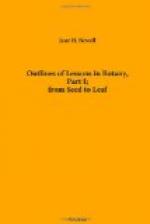[Footnote 1: The Power of Movement in Plants. By Charles Darwin. London. John Murray, 1880.]
[Footnote 1: Reader in Botany. IV. Movements of Seedlings.]
5. Leaves of Seedlings.—Coming now to the question as to the number of leaves at each joint of the stem, the Morning-Glory, Sunflower, and Bean will present no difficulty, but probably all the pupils will be puzzled by the Pea. The stipules, so large and leaf-like, look like two leaves, with a stem between, bearing other opposite leaves, and terminating in a tendril, while in the upper part it could not be told by a beginner which was the continuation of the main stem. For these reasons I left this out in the questions on the Pea, but it should be taken up in the class. How are we to tell what constitutes a single leaf? The answer to this question is that buds come in the axils of single leaves; that is, in the inner angle which the leaf makes with the stem. If no bud can be seen in the Pea, the experiment may be tried of cutting off the top of the seedling plant. Buds will be developed in the axils of the nearest leaves, and it will be shown that each is a compound leaf with two appendages at its base, called stipules, and with a tendril at its apex. Buds can be forced in the same way to grow from the axils of the lower scales, and even from those of the cotyledons, and the lesson may be again impressed that organs are capable of undergoing great modifications. The teacher may use his own judgment as to whether he will tell them that the tendril is a modified leaflet.
[Illustration: FIG. 9. 1. Grain of Indian Corn. 2. Vertical section, dividing the embryo, a, caulicle: b, cotyledon; c, plumule. 3. Vertical section, at right angles to the last.]
6. Monocotyledons.—These are more difficult. Perhaps it is not worth while to attempt to make the pupils see the embryo in Wheat and Oats. But the embryo of Indian Corn is larger and can be easily examined after long soaking. Removing the seed-covering, we find the greater part of the seed to be albumen. Closely applied to one side of this, so closely that it is difficult to separate it perfectly, is the single cotyledon. This completely surrounds the plumule and furnishes it with food from the albumen. There is a line down the middle, and, if we carefully bend back the edges of the cotyledon, it splits along this line, showing the plumule and caulicle within. The plumule consists of successive layers of rudimentary leaves, the outer enclosing the rest (Fig. 10, 1, c). The latter is the first leaf and remains undeveloped as a scaly sheath (Fig. 10, 2, c). In Wheat and Oats the cotyledon can be easily seen in the largest seedlings by pulling off the dry husk of the grain. The food will he seen to have been used up.
[Illustration: FIG. 10. 1. Germination of Indian corn. 2. Same more advanced. a, caulicle; c1, first leaf of the plumule, sheathing the rest; c2, second leaf; c3, third leaf of the plumule; d, roots.]




